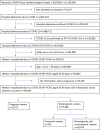COVID-19 outcomes in hospitalized puerperal, pregnant, and neither pregnant nor puerperal women
- PMID: 34780549
- PMCID: PMC8592461
- DOI: 10.1371/journal.pone.0259911
COVID-19 outcomes in hospitalized puerperal, pregnant, and neither pregnant nor puerperal women
Abstract
Objective: To compare hospitalized reproductive age women with COVID-19 who were pregnant, puerperal, or neither one nor the other in terms of demographic and clinical characteristics and disease progression using Brazilian epidemiological data.
Methods: A retrospective analysis of the records of the Information System of the Epidemiological Surveillance of Influenza of the Health Ministry of Brazil was performed. It included the data of female patients aged 10 to 49 years hospitalized because of severe COVID-19 disease (RT-PCR+ for SARS-CoV-2), from February 17, 2020 to January 02, 2021. They were separated into 3 groups: pregnant, puerperal, and neither pregnant nor puerperal. General comparisons and then adjustments for confounding variables (propensity score matching [PSM]) were made, using demographic and clinical characteristics, disease progression (admission to the intensive care unit [ICU] and invasive or noninvasive ventilatory support), and outcome (cure or death). Deaths were analyzed in each group according to comorbidities, invasive or noninvasive ventilatory support, and admission to the ICU.
Results: As many as 40,640 reproductive age women hospitalized for COVID-19 were identified: 3,372 were pregnant, 794 were puerperal, and 36,474 were neither pregnant nor puerperal. Groups were significantly different in terms of demographic data and comorbidities (p<0.0001). Pregnant and puerperal women were less likely to be symptomatic than the women who were neither one nor the other (72.1%, 69.7% and 88.8%, respectively). Pregnant women, however, had a higher frequency of anosmia, and ageusia than the others. After PSM, puerperal women had a worse prognosis than pregnant women with respect to admission to the ICU, invasive ventilatory support, and death, with OR (95% CI) 1.97 (1.55 - 2.50), 2.71 (1.78 - 4.13), and 2.51 (1.79 - 3.52), respectively.
Conclusion: Puerperal women were at a higher risk for serious outcomes (need for the ICU, need for invasive and noninvasive ventilatory support, and death) than pregnant women.
Conflict of interest statement
The authors have declared that no competing interests exist.
References
-
- World Health Organization. WHO Director-General’s opening remarks at the media briefing on COVID-19 - 11 March 2020. Available from: https://www.who.int/director-general/speeches/detail/who-director-genera...
-
- WHO COVID-19 Dashboard [Internet]. Geneva: World Health Organization, 2021. - [cited 2021 Jun 28]. Available from: https://covid19.who.int/
-
- Chen H, Guo J, Wang C, Luo F, Yu X, Zhang W,et al.. Clinical characteristics and intrauterine vertical transmission potential of COVID-19 infection in nine pregnant women: a retrospective review of medical records. Lancet. 2020;395(10226):809–815. doi: 10.1016/S0140-6736(20)30360-3 - DOI - PMC - PubMed
-
- Kasraeian M, Zare M, Vafaei H, Asadi N, Faraji A, Bazrafshan K, et al.. COVID-19 pneumonia and pregnancy; a systematic review and meta-analysis. J Matern Fetal Neonatal Med. 2020;1–8. - PubMed
Publication types
MeSH terms
LinkOut - more resources
Full Text Sources
Medical
Research Materials
Miscellaneous


